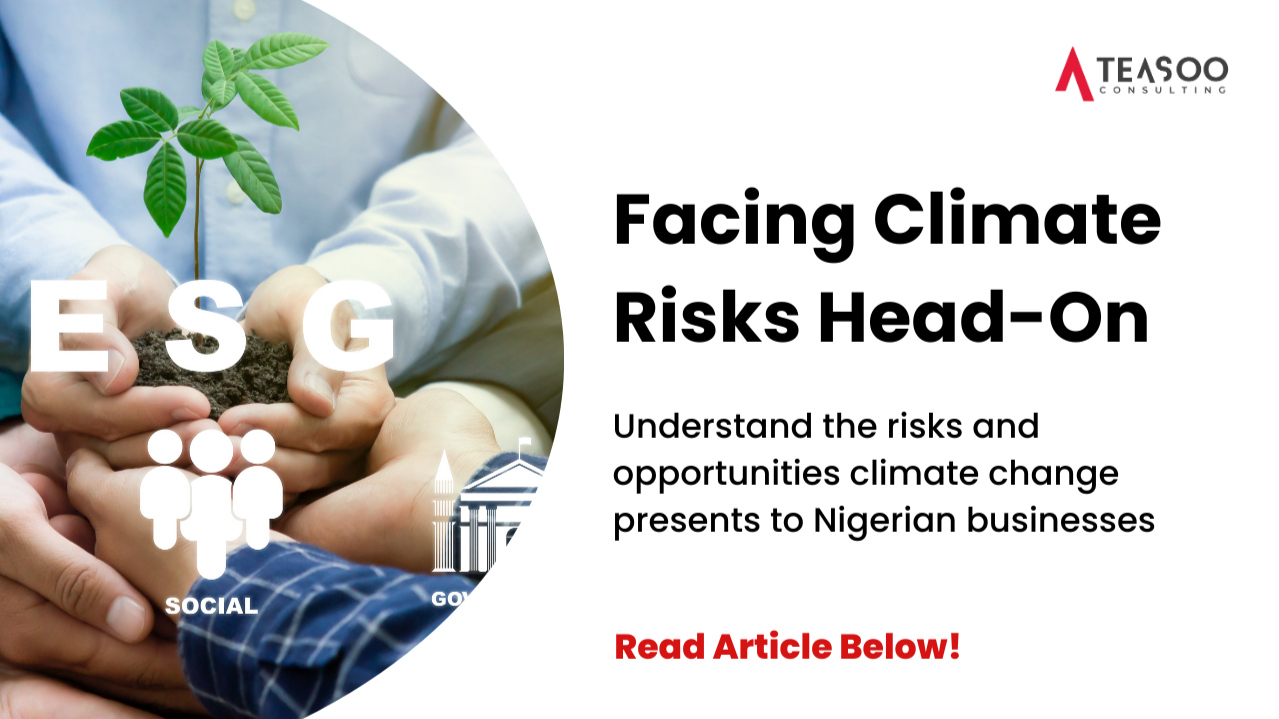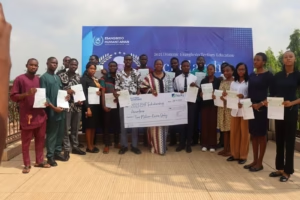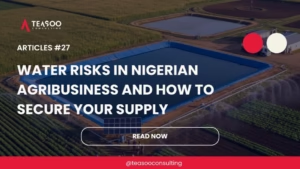#5 Climate Risks and Opportunities for Nigerian Businesses

- Nigerian businesses face physical climate risks that could shave off up to 3.6% of GDP by 2050 if unaddressed (World Bank, 2024)
- Agriculture—which contributes 23.4% of GDP—is highly vulnerable to droughts and floods (World Bank, 2023)
- Less than 1% of Nigeria’s GDP is mobilized as tracked climate finance, compared to $9.3 billion in fossil-fuel subsidies (Climate Policy Initiative, 2024)
- Nigeria has an estimated 210 GW of solar PV and 3.2 GW of wind capacity ready for development (Georgetown University, 2024)
- Every 1 °C rise in average temperature could reduce African GDP by 2%, underscoring regional spillovers that affect Nigerian markets (IPCC, 2022)
Nigeria’s businesses are on the frontlines of a shifting climate. From intensified flooding in the Niger Delta to longer dry seasons across the north, the country’s economic backbone, particularly agriculture, faces mounting threats. Yet, within these challenges lie vast opportunities in renewables, resilience-building services, and green finance solutions that can drive new revenue streams and safeguard long-term growth.
Climate Risks Facing Nigerian Businesses
Physical Hazards and Economic Exposure
Nigerian industries already contend with extreme weather events that have become more frequent and severe. Over the last two decades, Nigeria lost 1.33 million hectares of tree cover, 13% of its 2000 baseline, releasing 724 million tonnes of CO₂ in the process (Global Forest Watch, 2024).
Floods in 2012 inflicted $16.9 billion in damages, equivalent to 1.4% of GDP that year, and displaced over one million people (DFID/World Bank, 2013). Longer-term modeling projects that, without adaptation, Nigeria could lose between 2–11% of GDP by 2028, a warning that is even starker as climate impacts intensify (DFID, 2009).
Sectoral Vulnerabilities
Agriculture, accounting for 23.4% of GDP, is particularly vulnerable to rainfall variability and extreme heat (World Bank, 2023). Drought cycles threaten staple crops like cassava and maize, while flash floods erode soils and disrupt planting seasons. The industrial and service sectors, heavily clustered in urban coastal areas, face asset damage and supply-chain interruptions from storm surges and infrastructure flooding.
Economic Impact of Inaction
Compounding the direct losses, climate shocks ripple through Nigeria’s economy. By 2050, sea-level rise alone could inundate parts of Lagos, home to over 20 million, disrupting ports, industries, and commerce (World Bank, 2024). The same analysis estimates mean GDP losses of 3.6% under a mid-range climate scenario (GFDL model), with high-impact scenarios reaching 4.5% (World Bank, 2024).
Beyond direct damage, each extreme event erodes investor confidence, raises insurance costs, and amplifies socioeconomic inequalities as small and informal businesses lack the buffers of larger firms.
Opportunities Amidst Climate Challenges
Renewable Energy Deployment
Nigeria’s renewable energy potential is vast. The country could harness up to 210 GW of solar photovoltaic (PV) capacity and 3.2 GW of wind, enough to transform its energy mix and reduce reliance on costly, polluting diesel generators (Georgetown University, 2024).
Key entry points for businesses:
- Off-grid and minigrid solutions for rural communities, tapping into abundant solar irradiance.
- Corporate PPA arrangements to power industrial clusters with clean energy.
- Local manufacturing of PV components and balance-of-system parts to capture value locally.
Climate Finance and Resilience Services
Despite its vulnerabilities, Nigeria attracted only USD 2.5 billion in tracked climate finance in 2021/22, less than 1% of GDP, and far below its USD 9.3 billion in fossil-fuel subsidies that year (Climate Policy Initiative, 2024). Scaling up resilience investments, flood defenses, climate-smart agriculture, and early warning systems, presents a multi-billion-dollar market.
Benefit-Cost Snapshot: Low-cost adaptation measures in Nigeria yield a 3.13:1 benefit-cost ratio by 2050, signaling lucrative returns for early movers (World Bank, 2024).
Strategies for Business Adaptation
1. Integrate Climate Risk Assessments
- Conduct sector-specific risk mapping to identify hotspots of physical exposure.
- Embed climate scenarios into financial planning and insurance procurement.
2. Diversify Supply Chains
- Source inputs from multiple regions to buffer against localized climate shocks.
- Invest in storage and logistics infrastructure resilient to heat and flooding.
3. Partner for Innovation
- Collaborate with fintechs to develop weather-indexed insurance products for SMEs.
- Co-invest with development banks in green bonds and blended-finance vehicles.
4. Enhance Resource Efficiency
- Retrofit facilities with energy-efficient technologies to reduce emissions and energy costs.
- Adopt water-saving irrigation in agribusiness and rainwater harvesting in manufacturing.
Takeaway
Nigeria stands at a crossroads: its businesses can either bear the escalating costs of climate inaction or seize high-growth opportunities in clean energy, resilience services, and sustainable agriculture. By mobilizing finance, forging public-private partnerships, and embedding climate risk management into core strategies, Nigerian enterprises can turn existential threats into engines of innovation and competitiveness.






